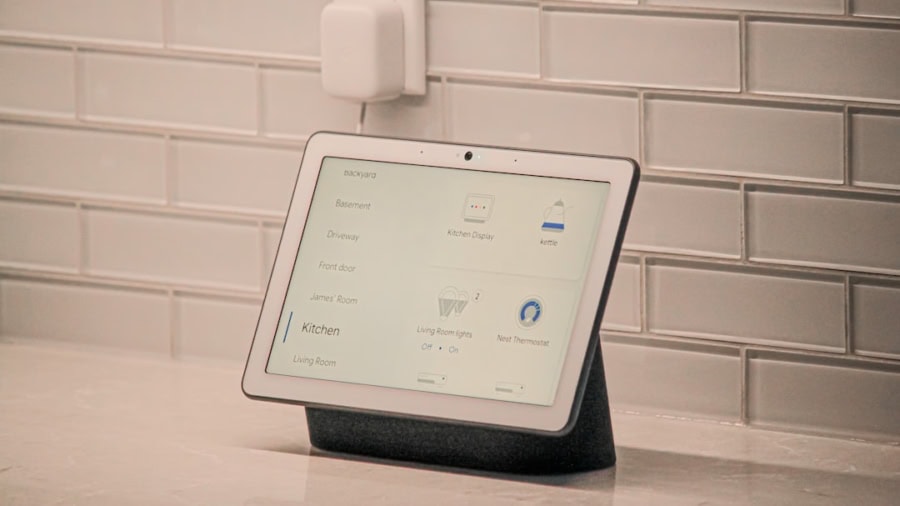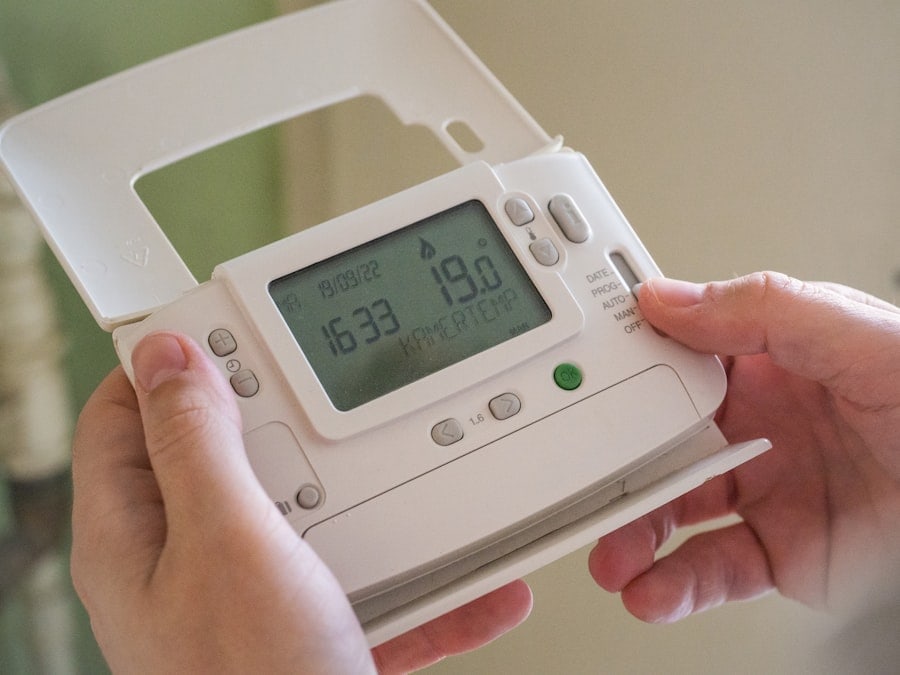Smart thermostats represent a significant leap forward in home automation and energy management. These devices, which can be programmed and controlled remotely via smartphones or other internet-connected devices, allow homeowners to optimize their heating and cooling systems with unprecedented precision. Unlike traditional thermostats, which require manual adjustments and lack the ability to learn from user behavior, smart thermostats utilize advanced algorithms and machine learning to adapt to the preferences and routines of their users.
This capability not only enhances comfort but also promotes energy efficiency, making them an attractive option for environmentally conscious consumers. The rise of smart thermostats is closely tied to the broader trend of the Internet of Things (IoT), where everyday devices are interconnected and capable of sharing data. This connectivity enables smart thermostats to gather information about energy usage patterns, local weather conditions, and even the presence of occupants in a home.
As a result, they can make real-time adjustments to heating and cooling schedules, ensuring that energy is used only when necessary. The integration of smart thermostats into home energy management systems is not just a technological advancement; it represents a paradigm shift in how we think about energy consumption and environmental responsibility.
Key Takeaways
- Smart thermostats are devices that can be programmed to adjust the temperature of a home based on the occupants’ schedule and preferences, and can be controlled remotely via a smartphone or other device.
- Smart thermostats have been shown to reduce energy consumption and save homeowners money on their utility bills by optimizing heating and cooling based on occupancy and weather conditions.
- Advancements in smart thermostat technology include features such as learning algorithms, geofencing, and integration with smart home systems, making them more intuitive and efficient.
- Smart thermostats play a crucial role in reducing carbon emissions by promoting energy efficiency and reducing the overall energy demand for heating and cooling.
- Case studies have demonstrated the significant impact of smart thermostats in reducing carbon footprints, with some households achieving up to 23% reduction in energy usage and carbon emissions.
- Smart thermostats have the potential to contribute to building sustainability by promoting energy efficiency and reducing the environmental impact of heating and cooling systems.
- Barriers to adoption of smart thermostats include cost, lack of awareness, and concerns about privacy and data security, which can be overcome through education, incentives, and improved product design.
- The future of smart thermostats holds promise in their role in climate change mitigation, with potential for integration with renewable energy sources and grid optimization to further reduce carbon emissions.
The Impact of Smart Thermostats on Energy Consumption
The impact of smart thermostats on energy consumption is profound and multifaceted. Studies have shown that these devices can lead to significant reductions in energy use, often by as much as 10-15% annually. This reduction is primarily achieved through the optimization of heating and cooling schedules based on actual occupancy patterns rather than static settings.
For instance, a smart thermostat can learn when a household is typically empty during the day and adjust the temperature accordingly, reducing unnecessary heating or cooling during those hours. Moreover, many smart thermostats come equipped with features such as geofencing, which uses the GPS capabilities of smartphones to determine when residents are away from home. When the last person leaves, the thermostat can automatically adjust the temperature to an energy-saving mode.
Conversely, as occupants return, the system can preemptively adjust the temperature to ensure comfort upon arrival. This dynamic approach to temperature control not only conserves energy but also enhances user satisfaction by maintaining a comfortable environment without manual intervention.
Advancements in Smart Thermostat Technology
The technological advancements in smart thermostats have been remarkable over the past decade. Early models primarily focused on basic programmability and remote access, but recent innovations have introduced features that significantly enhance their functionality. For example, many modern smart thermostats now incorporate machine learning algorithms that analyze user behavior over time, allowing them to predict future heating and cooling needs with increasing accuracy.
This predictive capability means that the thermostat can adjust settings proactively rather than reactively, further optimizing energy use. Additionally, integration with other smart home devices has become a hallmark of advanced smart thermostats. Many models now work seamlessly with smart speakers, lighting systems, and even security cameras, creating a cohesive ecosystem that enhances overall home automation.
For instance, a smart thermostat can communicate with a smart lighting system to adjust both temperature and lighting based on occupancy patterns, maximizing energy savings while ensuring comfort. Furthermore, some devices now offer integration with renewable energy sources, such as solar panels, allowing homeowners to optimize their energy consumption based on real-time production data.
The Role of Smart Thermostats in Reducing Carbon Emissions
Smart thermostats play a crucial role in reducing carbon emissions by promoting energy efficiency in residential settings. The energy sector is one of the largest contributors to greenhouse gas emissions globally, with heating and cooling representing a significant portion of residential energy use. By optimizing these systems, smart thermostats help lower overall energy consumption, which in turn reduces the demand for electricity generated from fossil fuels.
This reduction is particularly impactful in regions where coal or natural gas is the primary source of electricity. Moreover, many smart thermostats provide users with insights into their energy consumption patterns and carbon footprint. By visualizing data on energy use and its environmental impact, these devices empower homeowners to make informed decisions about their energy consumption habits.
This educational aspect not only fosters greater awareness of individual contributions to climate change but also encourages more sustainable practices among users.
Case Studies: How Smart Thermostats Have Reduced Carbon Footprints
Numerous case studies illustrate the tangible benefits of smart thermostats in reducing carbon footprints across various settings. One notable example comes from a pilot program conducted by a utility company in California, where participants were provided with smart thermostats and incentives for reducing energy consumption during peak hours. The results were striking: participants reduced their energy use by an average of 12%, leading to a significant decrease in carbon emissions associated with electricity generation during those peak periods.
Another compelling case study involves a large-scale implementation of smart thermostats in public housing units in New York City. The initiative aimed to improve energy efficiency while providing residents with greater control over their heating systems. Over the course of the program, participating households reported an average reduction in heating costs of 20%, translating into lower overall energy consumption and reduced carbon emissions.
The success of this initiative not only benefited residents financially but also contributed to the city’s broader sustainability goals by decreasing reliance on fossil fuel-based heating sources.
The Potential of Smart Thermostats in Building Sustainability
Optimizing Energy Efficiency in Commercial Buildings
In commercial buildings, where energy consumption is often significantly higher than in residential settings, smart thermostats can help optimize HVAC systems for maximum efficiency. By integrating these devices into building management systems, facility managers can monitor and control temperature settings across multiple zones, ensuring that energy is used efficiently throughout the entire structure.
Facilitating Green Building Certifications
Smart thermostats can also facilitate compliance with green building standards and certifications such as LEED (Leadership in Energy and Environmental Design).
A Standard Practice in Building Design and Management
As more organizations prioritize sustainability in their operations, the adoption of smart thermostats will likely become a standard practice in building design and management.
Barriers to Adoption and How to Overcome Them
Despite the clear benefits of smart thermostats, several barriers hinder widespread adoption among consumers. One significant challenge is the upfront cost associated with purchasing and installing these devices. While many models are becoming more affordable, the initial investment can still be a deterrent for some homeowners, particularly those on tight budgets.
To overcome this barrier, utility companies and governments can offer incentives such as rebates or tax credits for purchasing smart thermostats, making them more accessible to a broader audience. Another barrier is the perceived complexity of installation and operation. Some consumers may feel intimidated by the technology or unsure about how to integrate it into their existing home systems.
To address this concern, manufacturers can provide clearer instructions and support resources, including video tutorials and customer service hotlines. Additionally, partnerships with local HVAC professionals can facilitate seamless installation processes for consumers who prefer expert assistance.
The Future of Smart Thermostats and Their Role in Climate Change Mitigation
Looking ahead, the future of smart thermostats appears promising as they continue to evolve alongside advancements in technology and growing awareness of climate change issues. As more households adopt these devices, their collective impact on energy consumption and carbon emissions could be substantial. Innovations such as enhanced artificial intelligence capabilities will likely enable even greater levels of automation and efficiency, allowing smart thermostats to adapt not only to user preferences but also to broader environmental conditions.
Moreover, as renewable energy sources become more prevalent in the electricity grid, smart thermostats will play an essential role in managing demand response strategies. By adjusting heating and cooling settings based on real-time data from renewable sources like solar or wind power, these devices can help balance supply and demand while minimizing reliance on fossil fuels during peak periods. In this way, smart thermostats will not only contribute to individual household sustainability but also support broader efforts toward climate change mitigation on a global scale.
In a recent article discussing the future of smart thermostats in reducing carbon footprints, it was highlighted how technology continues to play a crucial role in sustainability efforts. This aligns with another article on the best tech products of 2023, which showcases how innovative gadgets are being developed to address environmental concerns. As smart thermostats become more advanced and energy-efficient, they are proving to be a key tool in reducing carbon emissions and promoting a greener lifestyle.
FAQs
What are smart thermostats?
Smart thermostats are devices that can be programmed to adjust the temperature of a home according to a schedule or controlled remotely through a smartphone, tablet, or computer. They can also learn the heating and cooling patterns of a home and adjust the temperature settings accordingly.
How do smart thermostats reduce carbon footprints?
Smart thermostats help reduce carbon footprints by optimizing energy usage. They can automatically adjust the temperature based on occupancy and can also provide energy usage reports, helping users to make more informed decisions about their energy consumption.
What is the future of smart thermostats in reducing carbon footprints?
The future of smart thermostats in reducing carbon footprints looks promising. As technology continues to advance, smart thermostats are expected to become even more efficient and integrated with other smart home devices, further reducing energy consumption and carbon emissions.
Are there any government incentives for installing smart thermostats?
Many governments offer incentives for installing smart thermostats as part of energy efficiency programs. These incentives can include rebates, tax credits, or other financial incentives to encourage the adoption of energy-saving technologies.
What are the potential cost savings of using smart thermostats?
Using smart thermostats can lead to significant cost savings on energy bills. By optimizing energy usage and reducing waste, smart thermostats can help homeowners and businesses save money on heating and cooling costs.



